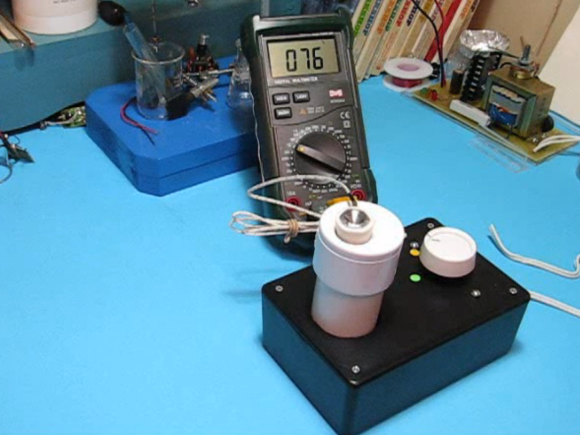
When working with chemical reactions it may be necessary to test the purity of the components you’re using. This is especially true with hobby chemists as they often acquire their raw materials from the hardware store, garden center, or pool supply. [Ken] figured out how to get around the $500 price tag of a commercial unit by building this DIY melting point test apparatus.
In this image he’s using a thermocouple to monitor the temperature of the melting surface, but mentions that you can do this with an inexpensive dial thermometer and will still have great results. That melting surface is the hexagonal head of a bolt which he drilled out to provide a concave surface for the test compound. Inside the PVC pipe is the heating element from a 40W hot glue gun. He wrapped it in fiberglass fabric which is sold in the plumbing supply to protect the area around pipe joints during soldering. The rotary light dimmer feeds the electricity to the element, allowing for adjustments to the ramping speed.















BTW, I think that you can find Protek 608 DMMs which have 4.5 digit resolution and used to come with a thermocouple. and read in degrees C or F. They talk 232. I paid $129 about a year ago. (Of course, they need an FTDI to hook up these days). The “cooling profile” reveals its “plateau” very nicely when you can see the data plotted.
Seems like the accuracy is way too low to be useful. Many compounds differ by less then a degree Celsius.
The accuracy in this project should be more than enough for hobbyist chemists trying to purify store bought chemicals.
vonskippy you are absolutely correct, but for home use it is possible to interpolate the closest value by using a slow ramp speed and having two values both over and under. I remember using a Fisher-Johns in a professional lab and being able to estimate fairly well. But, it is not like a good capillary system but it does work well enough. Thanks for the comment.
Glow plugs for diesel engines can potentially could make useful 12V heating elements. I’ve powered them from modified ATX power supply units. Resistance aprox 1Ohm at room temps to 14 Ohm when glowing red hot. P=V^2 R for heating output and with calibration could form a built in temperature sensor- eg a constant current supply then measuring voltage to work out resistance. Perhaps cast molten aluminium directly around a glow plug [as per Gingery casting alu around steel rod to form preformed bores] Glow plug would then be in exceptionally good contact with the aluminium, so should heat the aluminium block without reaching red heat.